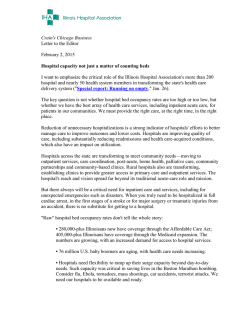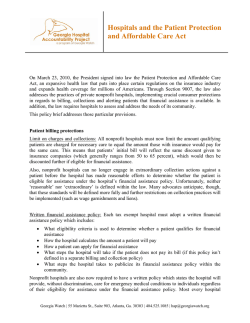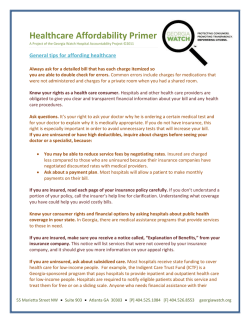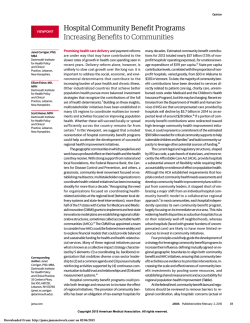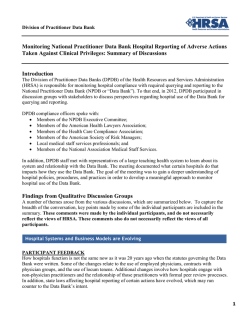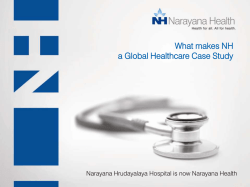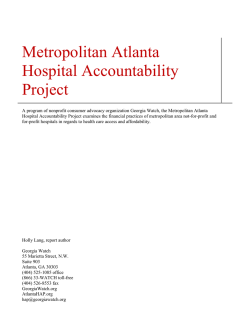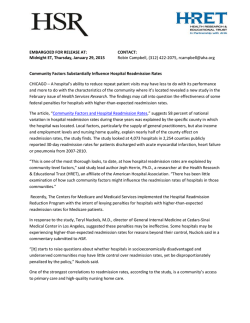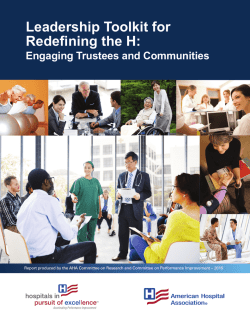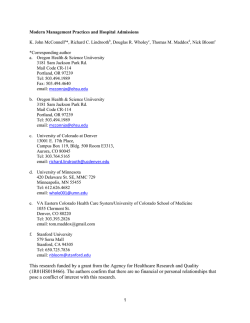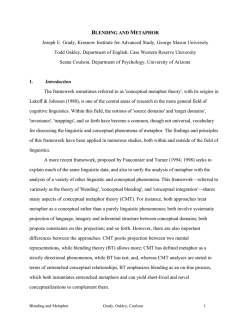
Georgia Hospital Primer
Georgia Hospital Primer A Project of the Georgia Watch Hospital Accountability Project ©2011 Summary Most Georgia Hospitals are non-profit corporations, meaning that any surplus income they receive must be re-invested in the hospital. Non-profit hospitals are exempt from paying property, sales, or income tax. Of these foregone tax revenues, property taxes make up the largest percentage. In exchange for this tax-exemption, a non-profit hospital is expected to give back to their community in other ways, such as through health screenings and community programs, direct financial assistance, operation of an emergency room available to all people, and participation in Medicaid and Medicare. The Patient Protection and Affordable Care Act (PPACA), signed into law in March 2010, requires non-profit hospitals to conduct tri-annual community health needs assessments and contains new reporting standards regarding their community benefits plans and financial assistance programs. Many Georgia hospitals are owned by a Hospital Authority, which acts as a transfer account for funds between the state and the hospitals. Grady Memorial Hospital, for example, is owned by the Fulton-DeKalb hospital authority. Safety net hospitals, such as Grady Memorial, provide services to large populations of uninsured and underinsured patients. Because safety net hospitals are under great financial strain, many have closed in recent years or re-structured in order to survive. Although most hospitals in Georgia are non-profit entities, several for-profit hospitals do exist and, although they do not have to, most offer some form of community benefits and financial assistance. Most hospital charges are inflated up to three times the actual cost of care. The discount received by an uninsured patient who qualifies for financial assistance may be smaller than the negotiated discount an insured patient would receive. Thus, the uninsured patient may actually end up paying more for care than an insured patient would have for the same procedure. Under the PPACA, non-profit hospitals will be required to charge uninsured patients qualifying for financial assistance no more than that generally billed to insured patients. 55 Marietta Street NW Suite 903 Atlanta GA 30303 [P] 404.525.1084 [F] 404.526.8553 georgiawatch.org GEORGIA HOSPITAL PRIMER Page |2 What is a non-profit hospital? What does “non-profit” mean? Most hospitals in the state are non-profit corporations under section 501(c)(3) of the Internal Revenue Service code. Any surplus money leftover at the end of their fiscal year must be re-invested in the hospital. As with other non-profit corporations, they are exempt from paying most taxes, including sales, income, and property taxes. For that reason, non-profit hospitals do not contribute fiscally to vital local infrastructure, such as road and sewer maintenance, public schools, or firefighter and police forces, even though these services are utilized by the hospital. Local property tax exemptions account for the largest amount of savings for tax-exempt nonprofit hospitals and medical facilities. The Congressional Budget Office (CBO) estimates that, nationally, non-profit hospitals receive $12.6 billion annually in tax exemptions, a figure that does not include $32 billion in federal, state, and local subsidies the hospital industry receives each year. Of the total value of those exemptions, local property taxes comprise the largest percentage—about 25 percent. State and local sales taxes comprise the second largest percentage at 22 percent; federal and state income taxes totals 24 percent; while tax-exempt bond financing comprises 14 percent. What obligations do they have? In exchange for its tax-exempt status, a non-profit hospital is required to: Have a mission that will benefit its community; Reinvest all surplus funds in the hospital in a way that benefits the community; Remain accountable to the community; Not allow any portion of its net earnings to benefit any private shareholder or individual; Operate a full-time emergency room that is available to all people, regardless of their ability to pay; Provide non-emergency services to anyone able to pay; and Participate in Medicaid and Medicare. How does the Affordable Care Act affect nonprofit hospitals? Through the Patient Protection and Affordable Care Act (PPACA), signed into law in March 2010, private non-profit hospitals must now meet new standards as a condition of their federal tax-exempt status, as well as undergo increased reporting and oversight mechanisms to ensure compliance with hospital charity care and community benefit standards while increasing transparency. Nonprofit hospitals must now develop written financial assistance policies, limit what they charge for services, observe fair billing and debt collection practices, and conduct regular community health needs assessments. Most of these requirements went into effect in 2011; the community health needs assessment requirement will begin in 2013. The Secretary of the Treasury and the IRS are charged with enforcing the new provisions and have authority to issue further guidance and regulations as needed to make sure they are correctly implemented. 55 Marietta Street NW Suite 903 Atlanta GA 30303 [P] 404.525.1084 [F] 404.526.8553 georgiawatch.org GEORGIA HOSPITAL PRIMER Page |3 Numerous regulations have already been written, outlining how hospitals may comply with the law; more regulations will be written before the PPACA goes into full effect in 2014. What are hospital authorities? Many hospitals in Georgia are owned by a county hospital authority. Established by an act of the state legislature in 1969, county hospital authorities act as a transfer account for funds between the state and the hospitals. If the hospital takes on debt for construction or other ventures, the hospital authority can issue bonds or other financing to pay for that debt. The authority has the right to approve management and contracts and is the only entity that can legally provide the intergovernmental transfer for Indigent Care Trust Fund (ICTF) and Disproportionate Share (DSH) funds, as well as similar governmental funds. Hospital authorities also hold the lease for a hospital system’s or facility’s property and oversee property and infrastructure decisions. By Georgia law, county hospital authorities may engage a non-profit entity to manage the hospital on its behalf, but the authority maintains ownership and all liabilities. Fulton-based hospitals Grady Memorial and Northside Hospital are both authority owned hospitals, for example. Grady Memorial Hospital is owned by the Fulton-DeKalb Hospital Authority, a jointly owned authority of both Fulton and DeKalb counties. Northside Hospital is owned by the Fulton County Hospital Authority. There are numerous other authority hospitals in the state of Georgia. What about safety net hospitals? What are they? Safety net hospitals are committed to providing high levels of indigent and charity care, serving the area’s low-income, uninsured, and vulnerable populations. Most of their patients have little to no access to stable health care coverage and are often uninsured, underinsured, Medicaid beneficiaries, or patients with special health care needs. Who are they? There are approximately 1,300 public safety net hospitals in the country—300 fewer than just 15 years ago. Many have closed due to financial strain, including facilities in Los Angeles, Washington, St. Louis and Milwaukee. In Georgia, Grady Memorial Hospital in Atlanta is the state’s largest safety net hospital, followed by Savannah’s Memorial University Medical Center. How much care do they give? According to the National Association of Public Hospitals, safety net members account for two percent of all hospitals but provide 25 percent of the nation’s uncompensated care. What are their challenges? Vulnerable populations may be three times more likely than privately insured individuals to experience adverse health outcomes and four times more likely 55 Marietta Street NW Suite 903 Atlanta GA 30303 [P] 404.525.1084 [F] 404.526.8553 georgiawatch.org GEORGIA HOSPITAL PRIMER Page |4 than insured patients to require hospitalization and expensive emergency care they can’t afford. For some patients, federal, state, and local governments will subsidize the health care costs through special programs. However, uninsured and underinsured patients not eligible for indigent or charity care may struggle to pay their medical bills and can fall into default or bankruptcy. Safety net hospitals are then left with these unpaid medical bills. What does the future look like for these hospitals? Public hospitals in major metropolitan areas, including Chicago, Miami, and Memphis, are currently facing severe financial shortfalls and must receive immediate assistance to stall or stop closure. Others, like Grady Memorial Hospital, have restructured as a way to survive. What are community benefits? Community benefits are programs offered to the community as an informal exchange for a nonprofit hospital’s tax-exempt status. These programs are meant to boost the health of the community served, especially that of its more vulnerable populations. Because they receive formidable tax breaks, non-profit hospitals are charged with addressing the health needs of their community. Those tax breaks are meant to spur the non-profit hospital to go above and beyond its for-profit counterparts in its offerings to the local community as a way to justify its non-profit status. Many facilities interpret this obligation solely as the provision of uncompensated care, but they should also consider community benefit programs. Community benefit programs can reduce the cost of uncompensated care for hospitals by improving the health of the community through cancer screenings, health education, and other such services that target uninsured and underinsured populations. Georgia does not require non-profit hospitals to meet a minimum standard of community benefits in exchange for these tax-exempt breaks, nor does it require a non-profit facility to provide information on those benefits beyond basic reporting of its indigent and charity care expenditures. Although new federal regulations do require extensive reporting of a non-profit hospital’s community benefits and financial assistance; they do not include any minimum standards. Some examples of community benefits other than traditional financial assistance include clinic support, health screenings, and appropriate follow-up care, to name a few. Through such programs, health conditions can be more affordably treated in a setting outside the emergency room, and conditions with a potential for high fiscal and physical impact will have more swift action, thus reducing the need for pricey hospital care. What taxes are not being paid? There are four primary taxes nonprofit hospitals do not pay: property taxes, state and local income taxes, sales taxes, and bond financing. Property taxes comprise the largest amount of a facility’s tax exemption—about 25%. Local tax assessors should annually evaluate the worth of 55 Marietta Street NW Suite 903 Atlanta GA 30303 [P] 404.525.1084 [F] 404.526.8553 georgiawatch.org GEORGIA HOSPITAL PRIMER Page |5 a hospital’s property, and the hospital should provide to its local and state government an estimation of the value of the income, bond financing, and sales tax exemption, if only in the interest of transparent and proper fiscal stewardship. In the absence of this transparency and stewardship, county and state authorities are able to calculate these values without the hospital’s input through a series of mathematical equations, though these equations will only provide a ballpark figure. Regardless, even having a baseline to calculate the worth of these exemptions is a first step towards the assurance that the community is indeed getting its value for those foregone taxes. These assessments can also aid in equalizing the amount of care provided and the strength of programs aimed at boosting the health of low-income and uninsured populations among various non-profit hospitals. Are there for-profit hospitals in Georgia? Yes. Several for-profit hospital corporations operate hospitals in Georgia, such as Tenet Healthcare Corporation and HCA Healthcare, to name a few. Atlanta Medical Center, for example, located near downtown Atlanta, is owned by Tenet Healthcare. These hospitals are allowed to distribute surpluses to shareholders as profit just like any other for-profit corporation. Even though not required to, most of these hospitals also have financial assistance plans and other community benefit programs similar to non-profit hospitals, which may, in some circumstances, be more generous. How are hospital costs computed? The cost of care has a direct impact on the patient’s ability to access health services. Controlling hospital charges is central to lowering overall health costs. Many metropolitan Atlanta hospitals charge more for their services than the actual cost of these services, which likely forces many patients to delay or avoid care for financial reasons. For example, in 2008, for every $1.00 a patient was charged at a metro Atlanta hospital, the hospital incurred an average cost of $0.33. The disparity between actual costs and amount charged may be estimated by using the hospital’s cost to charge ratios as reported to the state Department of Community Health (more commonly referred to as “DCH”). In 2008, the five most expensive hospitals in the metropolitan area were, in order from highest to lowest, North Fulton Hospital, Cartersville Medical Center, South Fulton Medical Center, Emory Eastside Hospital, and Atlanta Medical Center. All are for-profit entities. That year, the five least expensive hospitals in the metropolitan area were, in order of lowest to highest, Walton Regional Medical Center, Grady Memorial Hospital, Emory University Hospital Midtown, Emory Johns Creek, and Emory University Hospital. Interestingly, the two facilities with the lowest mark-ups also offer the highest amount of uncompensated care. 55 Marietta Street NW Suite 903 Atlanta GA 30303 [P] 404.525.1084 [F] 404.526.8553 georgiawatch.org GEORGIA HOSPITAL PRIMER Page |6 Hospital representatives and industry professionals defend the difference between what a patient is charged versus what the service or product actually costs as a means to offset the cost of providing unreimbursed care for low-income, uninsured or underinsured patients who do not qualify for financial assistance and are unable to pay their bills. Generally speaking, even when hospitals provide a discount, the difference between the actual cost and the amount charged is significant. For example, a self-pay patient receives a hospital bill for $3,500 for services that cost the hospital $1,060. The patient is eligible for a 20 percent discount (about $700) so the patient owes the hospital $2,800, which is about 2.6 times what it cost the hospital to provide the service. An uninsured patient, on the other hand, would pay an even further discounted rate (as negotiated by the patient’s insurance carrier). Therefore, an uninsured patient could owe the hospital more than the hospital would have ever received had that patient been insured. Fortunately, the PPACA contains new provisions that require a nonprofit hospital to only charge uninsured patients qualifying for financial assistance the amounts generally billed to insured patients. ______________________________________________________________________________ More information on non-profit hospitals and their community benefits can be found at http://www.communitycatalyst.org/projects/hap/ 55 Marietta Street NW Suite 903 Atlanta GA 30303 [P] 404.525.1084 [F] 404.526.8553 georgiawatch.org
© Copyright 2024
